
The aquarium at the Ocean Plaza shopping mall is the largest public aquarium in Eastern Europe. Visitors to the mall can observe the mysterious world of underwater creatures from just an arm’s length away. The aquarium features four transparent walls—three facing the atrium and one opening into the Marlin restaurant behind it—revealing the beauty of an underwater reef and its many vibrant inhabitants. Sharks, stingrays, moray eels, and starfish are just a few of the species that can be seen behind the thick glass.hanks to a high-tech water circulation system, an artificial current is created within the aquarium. This allows sharks to breathe freely even when they are stationary. The most advanced life support and ecosystem maintenance system ensures optimal living conditions for all the aquarium’s inhabitants.
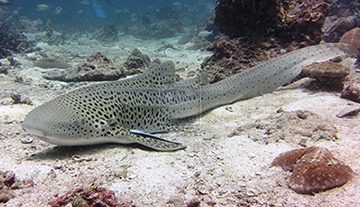
The zebra shark (Ginglymostoma cirratum) – is the only species in the family Stegostomatidae. It is easily recognizable by its spotted pattern, long tail, and longitudinal ridges along its sides. This species is found in tropical and subtropical waters of the Pacific and Indian Oceans and occasionally appears in the southern part of the Sea of Japan.Zebra sharks can grow up to 2.3 meters in length, with rare specimens reaching 3 meters. In our aquarium, we are proud to have not just one but two of these amazing sharks thriving and swimming gracefully!
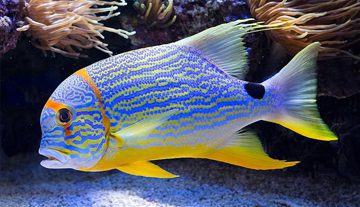
The blue-striped symphorichthys (Symphorichthys spilurus) – also known as the marine perch or sea bream, is a type of perch native to the Indo-Pacific region. It inhabits coral reefs in areas with sandy substrates at depths ranging from 5 to 60 meters.This is a solitary fish that only groups together with others of its own species. It can reach a length of up to 60 cm.
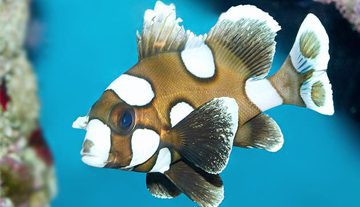
The harlequin sweetlips (Plectorhynchus chaetodonoides) – belongs to the sweetlips family (Haemulidae). It can grow up to 72 cm in length and is closely associated with coral reefs.This species inhabits coral-rich areas, including lagoons and the outer, seaward-facing slopes of reefs, at depths ranging from 1 to 30 meters. Adult individuals are typically found alone near caves and under overhangs. They feed on crustaceans, mollusks, and small fish, usually during nighttime.
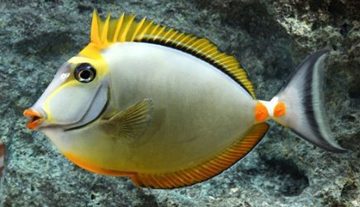
The elegant unicornfish (Naso elegans) – is native to the Indian Ocean, including the Red Sea, extending south to Durban, South Africa, and eastward across the islands of the western Indian Ocean to southwestern Indonesia.These fish are commonly found along the outer slopes of coral reefs and in calm lagoons at depths ranging from 3 to 100 meters. Adults typically swim alone or in pairs, while juveniles prefer to stay in schools. In the wild, they can grow to about 45 cm in length.
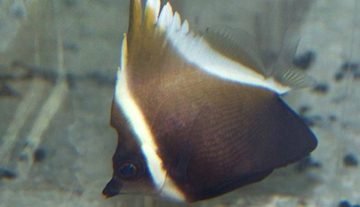
The brown bannerfish (Heniochus varius) – is distinguished by its short banner and several elongated fin rays behind it, forming a characteristic triangular sail.This small, elegant butterflyfish has a calm and shy nature. It can grow up to a maximum size of 20 cm.
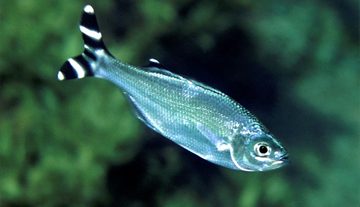
The barred flagtail (Kuhlia mugil) – is a silver-colored fish with large eyes, an oval body, a deep notch between the spiny and soft parts of its continuous dorsal fin, and a small, slightly oblique mouth.These fish do not grow very large—the biggest specimens barely exceed 25–30 cm in length. They are found exclusively in the warm waters of the Pacific and Indian Oceans, inhabiting coastal areas. They often venture into estuaries and river mouths, occasionally even entering freshwater.
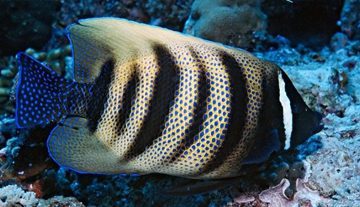
The sixband angelfish (Euxiphipops sexstriatus) – inhabits the eastern Indian Ocean and the western Pacific Ocean. It can be found in a variety of environments, from turbid lagoons to the clear waters of outer coral reef slopes, at depths ranging from 5 to 60 meters.This species is usually seen in pairs and rarely alone, while juveniles prefer shallow, sheltered reef areas. It is omnivorous, feeding on sponges, worms, mollusks, fish eggs, and a variety of other foods, including plant matter.
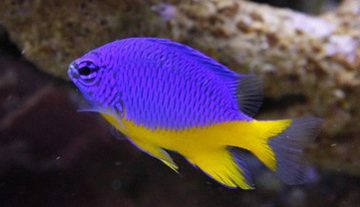
The blue-and-yellow damselfish (Chrysiptera hemicyanea) – is one of the most strikingly colored reef fish. Its body is a vivid blue, while its belly and tail fin are bright yellow—an especially interesting detail for us, considering the colors of our national flag.The fish also has numerous thin, short, vertical black lines on the blue areas and a few light blue spots below the eyes.Chrysiptera hemicyanea is often mistaken for Chrysiptera parasema, as they share a similar color pattern. However, Chrysiptera parasema has a metallic sheen, making it less reminiscent of our national colors.
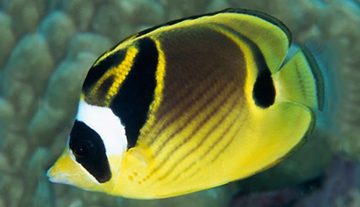
The raccoon butterflyfish (Chaetodon lunula) – naturally inhabits lagoons and outer reef slopes along the eastern coast of Africa, Australia, Hawaii, Fiji, and Papua New Guinea. It can also be found in small numbers in the southeastern Atlantic Ocean.In the wild, the raccoon butterflyfish can grow up to 20 cm in length, while in an aquarium, its maximum size typically ranges from 16 to 18 cm.
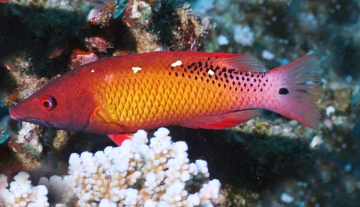
The Diana’s hogfish (Bodianus diana) — is a species of ray-finned fish from the wrasse family. It grows up to 25 cm in length and feeds on small fish, invertebrates, and worms. Juveniles may act as cleaner fish. It is easily recognizable by 4-5 white spots beneath the dorsal fin, as well as black spots on the pelvic and anal fins. This species inhabits depths of 5 to 30 meters.
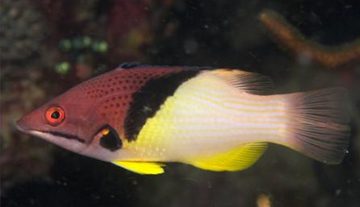
The dark-headed hogfish (Bodianus mesothorax) – is widely distributed in the Indo-western Pacific region, along the coasts of Indonesia, the Great Barrier Reef, Micronesia, the Philippines, Palau, and Japan. Adult fish swim at depths ranging from 5 to 20 meters among rocky coral reefs. Juvenile fish prefer to hide in crevices, while adults are found in open areas near rocky formations, where they can quickly retreat into a cave if danger arises. The dark-headed hogfish adapts quickly to aquarium conditions, but as it grows, it can become quite aggressive. Therefore, if you decide to keep this fish, it’s important to carefully consider its temperament and the potential challenges it might bring.
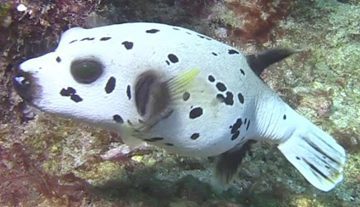
The black-spotted pufferfish (Arothron nigropunctatus) – is found in the Indo-Pacific region, including areas near East Africa, Micronesia, Samoa, New South Wales, northern and southern Japan, and occasionally in the Red Sea. It inhabits outer reef slopes and lagoons at depths ranging from 3 to 25 meters. Adult individuals are typically solitary or found in pairs. They feed on crustaceans, mollusks, sponges, and algae. This species can grow to a length of 25–30 cm. The fish has a distinctive appearance: its body is generally white-gray, with black spots on the back, sides, and tail fin. The fins are yellowish, and its mouth and eyes are brown. When threatened, the fish can inflate itself, doubling in size as a defense mechanism.
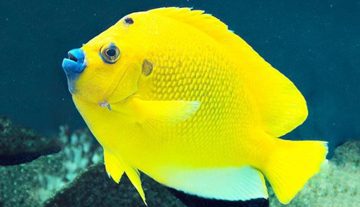
The three-spot angelfish (Apolemichtys trimaculatus) – is a medium-sized angelfish, mostly lemon-yellow in color. Due to its vibrant coloration and relatively small size, this species is the most popular among aquarists. It can grow up to 25 centimeters in length, although in aquariums, they usually do not exceed 20 centimeters.
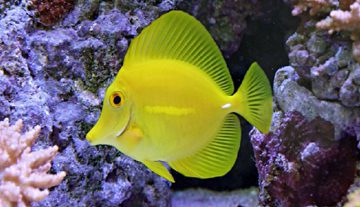
The yellow tang (Zebrasoma flavescens) – is found in the wild from Hawaii to Japan, as well as along the coasts of Wake, Marcus, Marshall, and Mariana Islands in the Pacific Ocean. These reef fish inhabit lagoons among coral reefs at depths of 3–45 meters and are typically seen either alone or in small groups. Unfortunately, the population of these fish has significantly declined due to factors such as worsening environmental conditions and uncontrolled fishing for the aquarium trade worldwide.
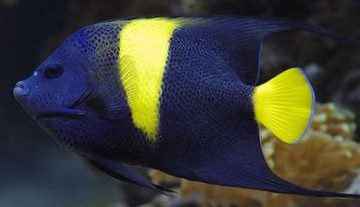
The Arabian angelfish (Pomacanthus asfar) – is found in the northwestern Indian Ocean, with a strong presence in the Persian Gulf and Red Sea. In these regions, the fish inhabit reef lagoons at depths of up to 20 meters. They prefer muddy areas with turbid waters. In the wild, these fish can grow up to 40 cm in length, while in aquariums, their size typically does not exceed 25 cm.
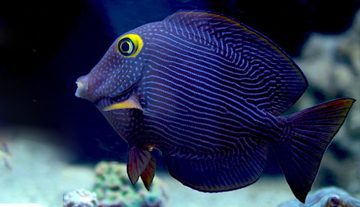
The yellow-eyed surgeonfish (Ctenochaetus strigosus) – is found in the eastern Pacific Ocean (Hawaiian Islands and Johnston Atoll) and the western part near Australia. They inhabit coral reefs and lagoons with rocky bottoms at depths ranging from 1 to 113 meters. These fish are typically solitary, but they form pairs for mating. On average, they reach a length of 15 cm.
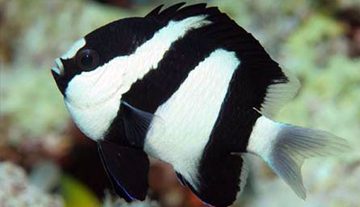
The zebra damselfish (Dascyllus melanurus) – is a small and beautiful marine fish that can grow up to 10 centimeters in length. It typically has a white coloration with four vertical black stripes. These fish inhabit coral reefs in the Indo-Pacific region and the Indo-Australian archipelago at depths ranging from 1 to 70 meters. They are known for their resilience. The zebra damselfish has an oval body that is flattened on the sides with a pointed snout. Its head features very large eyes and small nostrils, typically one or two on each side of the body.
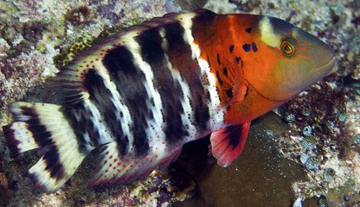
The red-breasted wrasse (Cheilinus fasciatus) – is found in the Indo-Pacific region, including the Red Sea, Eastern Africa, Micronesia, Samoa, and the Ryukyu Islands. Adult individuals live in lagoons and coral reefs in areas with sandy, gravelly, and coral substrates at depths ranging from 4 to 40 meters. They feed on benthic invertebrates, mollusks, crustaceans, and sea urchins. Juvenile fish inhabit the edges of reefs where there is abundant algae and sandy substrate. Adults can grow up to 40 centimeters in length.
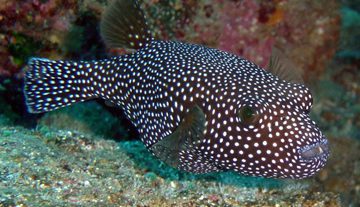
The spotted pufferfish (Arothron meleagris) – is a species of ray-finned fish from the pufferfish family. Its body can reach up to 50 cm in length. The species is named for the numerous white spots that cover its black body. There is also a yellow color morph that is not covered by spots.
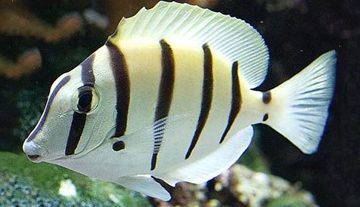
The zebra surgeonfish (Acanthurus triostegus) – is a species of marine ray-finned fish from the surgeonfish family. These coastal fish are primarily herbivorous, though they occasionally feed on small benthic invertebrates. They can grow up to 21 cm in length.
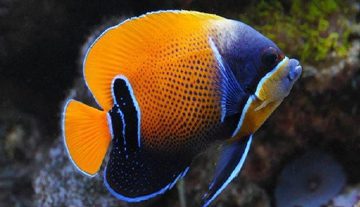
The orange angelfish (Euxiphipops navarchus) – is the smallest and most shy of the 13 species in the Pomacanthus genus commonly kept in reef aquariums, growing up to 28 centimeters. It is found in the Caribbean, Maldives, and Sri Lanka, where it typically swims alone near coral reefs in lagoons and on the outer slopes of reefs. Juveniles tend to stay hidden in shallow waters, while adults dive deeper, reaching depths of up to 40 meters. This species can live up to 21 years.
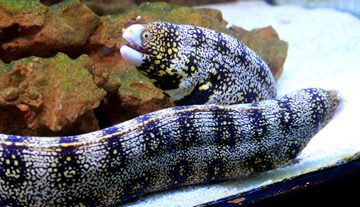
The snowflake moray (Echidna nebulosa) – is found along rocky coastlines, coral reefs, and among the vegetation of the Indo-Pacific region, ranging from the Red Sea and the eastern coast of Africa to the Gulf of California, Mexico, and Costa Rica. This fish resembles an eel in shape but lacks pectoral and pelvic fins. It moves through the water in a serpentine, undulating motion, similar to how reptiles like snakes and vipers move on land. The dorsal fin begins just in front of the gill slit and runs along the entire body, which is adorned with distinctive white and black spots. The moray has a rounded snout and jaws equipped with strong teeth.
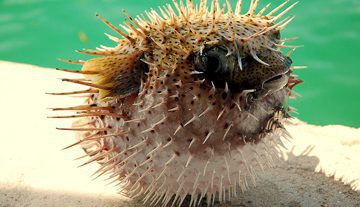
The common pufferfish (Diodon hystrix) – belongs to the family Tetraodontidae and is known for its ability to inflate itself by swallowing water or air into a stomach-connected air sac. Its body is covered with spines. On average, this fish grows to about 35 cm in length.
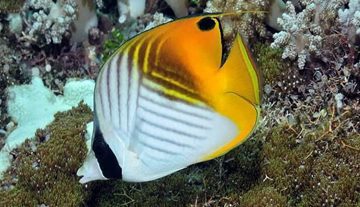
The threadfin butterflyfish (Chaetodon auriga) – has a wide distribution range, from the Red Sea to the Hawaiian Islands and the southern part of Japan. Like other butterflyfish species, this one is typically found on the outer side of coral reefs. The threadfin butterflyfish generally resides at depths ranging from 1-5 meters to 30-40 meters. Therefore, it is relatively easy to encounter this fish both while snorkeling and diving.
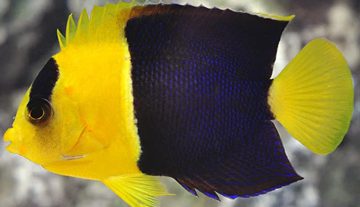
The bicolor angelfish (Centropyge bicolor) – is found in the wild from the eastern part of Africa to Samoa. These fish are commonly seen in coral reefs, where they swim at depths of 10-25 meters. In areas with clear water and abundant hiding spots, they can even live near the water’s surface. Centropyge bicolor has a striking yellow and blue coloration. In aquarium conditions, the fish typically reach a size of 12-15 cm.
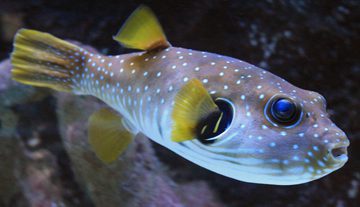
The spiny pufferfish (Arothron hispidus) — is a member of the Tetraodontidae family and is found in the Red Sea, the Indian and Pacific Oceans, especially along the coasts of California and Panama, north of Japan and the Hawaiian Islands, as well as in the Cape Province. These spiny puffers are typically gray or green-brown in color, with their sides and tail fin covered in white spots and small spines. In the Red Sea population, the spots are smaller but more numerous. Spiny puffers can grow up to 50 cm in length. They live near the seafloor and tend to lead solitary lives, guarding their own territory.
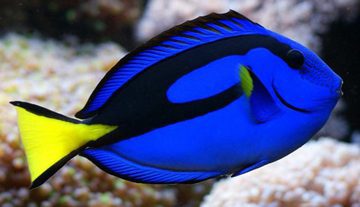
The Blue Surgeonfish (Paracanthurus hepatus) — also known as the blue tang or royal blue tang, is a species of fish from the Acanthuridae family, found in the Indo-Pacific region. This fish has a bright royal blue body color, a yellow tail, and a black spot that resembles a palette, making it easily recognizable. The lower part of the body in individuals from the western-central Indian Ocean has a yellowish tint. The Blue Surgeonfish has a flat, rounded body with a sharp nose and small scales. It has nine spines and 26-28 rays on the dorsal fin, three spines and 24-26 rays on the anal fin. When threatened, the fish can become semi-transparent to confuse potential predators. This species grows up to 30 cm in length and is popular among aquarists due to its beautiful coloration and interesting behavior.
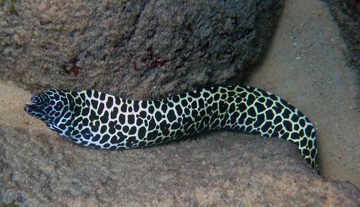
The Leopard Moray (Gymnothorax favagineus) – is a large, massive moray eel and one of the largest species of moray eels in the Indo-Pacific. It can reach up to three meters in length. The species is distinguished by its striking, contrasting coloration, with black spots on a white background. The maximum size typically reaches up to 70 cm.
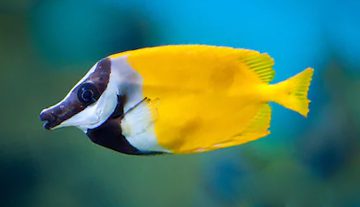
The Foxface (Lo vulpinus) – is a herbivorous fish from the family Siganidae, commonly known as the sea fox family. This family is small and monotypic, consisting of a single genus with 28 species. Members of the Siganidae family are primarily herbivores, feeding on benthic algae in their natural habitat. The Foxface typically reaches sizes ranging from 20 to 50 cm and weighs around 0.5 kg, with a maximum size of 24-30 cm.
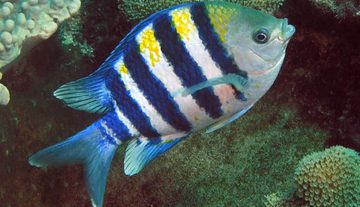
The Sergeant Major (Abudefduf saxatilis) – is one of the most common fish in the Red Sea and the Adriatic Sea. It belongs to the class of bony fish, order Perciformes, family Pomacentridae, and was first described in 1825. In the wild, its maximum body length reaches up to 18 cm, although in aquariums it is typically smaller. This fish typically inhabits depths ranging from one to fifteen meters in natural conditions.
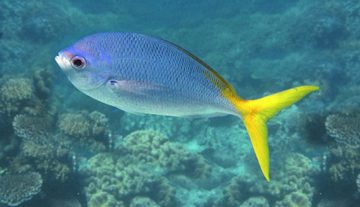
The Yellowtail Caesar (Caesio cuning) – is a resident of tropical waters, feeding on plankton and forming large schools above coral reef tops and drop-offs in areas with strong currents rich in plankton. Caesar fusiliers, when away from the reef, typically display blue colors with blue and yellow stripes, which make them blend in with the blue water. However, as they approach the reefs or cleaning stations (where cleaner wrasse remove parasites from their skin), their coloration becomes significantly brighter, with red and yellow spots appearing. This makes them less noticeable among the coral reefs.